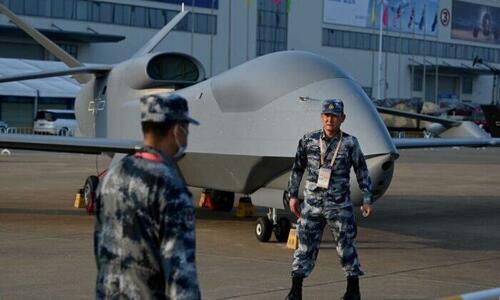
Китайские дроны и американские лазеры: грядущие революции в войне
Автор: Андерс Корр, The Epoch Times
Учитывая Грядущие технологические революции Во время войны важно, чтобы Соединенные Штаты и наши союзники вышли на фронт рано. сохранить лидерство и ослабить возможности противника.

В наши дни китайские беспилотники-истребители «лояльного крыла» получают много внимания. Вингмен - это множитель силы, предназначенный для полета в количестве рядом с его пилотируемыми реактивными истребителями или для руководства флотом небольших беспилотников. Если развернуть в рое, вингмены и небольшие беспилотники могут быстро подавить флот пилотируемых истребителей и ПВО. Они оснащены реактивным двигателем, но гораздо дешевле, чем обычный истребитель, отчасти потому, что им не требуется обученный пилот. Некоторые смоделированные бои между пилотами-людьми и пилотами искусственного интеллекта (ИИ), которые учатся на лету, привели к победам ИИ еще в 2020 году.
Последняя итерация китайского беспилотного летательного аппарата Feihong FH-97A, по-видимому, значительно улучшилась по сравнению с более ранними версиями, представленными в 2022 и 2023 годах. Сообщается, что FH-97A быстрее, чем его американский аналог XQ-58A Valkyrie. Дальность полета FH-97A составляет около 620 миль. Текущего диапазона более чем достаточно, чтобы достичь любой точки Тайваня, а также морских путей на восточной стороне острова, которые будут иметь решающее значение для обеспечения Тайваня в случае войны или морской блокады. Из китайских владений FH-97A может охватывать всю Южную Корею, Восточно-Китайское море, части Японии и Филиппин и все Южно-Китайское море через островные прыжки на аэродромах Китая и искусственных островах.
Более того, FH-97A в будущем может быть использован для нападения на любую часть Соединенных Штатов или Европы, учитывая, что он может катапультироваться с авианосцев и потому, что Народно-освободительная армия (НОАК) планирует предоставить ему возможности воздушной дозаправки. Беспилотники добавят силы другим последним инновациям ВВС НОАК (и кражам из США), включая стелс-истребители и стелс-бомбардировщики. Беспилотники могут использоваться для воздушных и наземных атак, радиоэлектронной борьбы, разведки и сопровождения бомбардировщиков.
В то время как Соединенные Штаты уже давно имеют более подготовленных летчиков-истребителей и более совершенные самолеты, что дает им превосходство в воздухе над Китаем, эти таблицы могут измениться. Без пилотов, а скорее без использования программ искусственного интеллекта, которые продемонстрировали превосходство, век высоких технологий и массового промышленного производства Китая может значительно превзойти Соединенные Штаты и решительно перенести превосходство в воздухе на НОАК.
Это будет иметь немедленные и тяжелые последствия для стран, уже находящихся под военным давлением Пекина, а именно Тайваня, Филиппин, Японии и Индии.
Одним из перспективных средств защиты от китайских беспилотников является лазерное оружие.Например, система HELIOS, развернутая на военно-морском эсминце США в 2022 году, и система DragonFire, протестированная Великобританией в январе.
Дракон Огневой лазер может уничтожать цели с точной точностью в прямой видимости выстрелами, которые прорежут механику дрона или взорвут его боеголовки. Каждый выстрел стоит менее 10 фунтов стерлингов (12,61 доллара США) для стрельбы в течение 10 секунд, предполагая, что они могут быть использованы для дешевого среза вражеской системы с повторными проходами. Сравните это со стоимостью ракеты-перехватчика в миллион долларов или более, что может быть пустой тратой денег против некоторых из самых дешевых иранских военных беспилотников, например, стоимостью не более 2000 долларов каждый. Британская система планируется к развертыванию на военно-морских кораблях страны к 2027 году, а британская армия также рассматривает возможность развертывания. Ученые в Китае также разрабатывают лазерное оружие, в том числе для использования из космоса.
Лазерное оружие может в конечном итоге свести на нет мощь межконтинентальных баллистических ракет и гиперзвуковых ракет, а также силовых надводных и воздушных комбатантов под водой, где лазеры неэффективны.
Подземные комбатанты могут стать относительно бесполезными против наземных целей, за исключением, возможно, ближайших к побережью. В случае с Украиной, например, широкое распространение лазерного оружия может создать тупик на долгие годы.
Соединенные Штаты в настоящее время являются самой сильной сверхдержавой в мире, считается экономически и в военном отношении. Многие приходили раньше, и ни один не длился вечно. Одна ошибка, которая приводит к потере технологического лидерства в Китае или России, например, может быть концом Соединенных Штатов, как мы его знаем. Теперь у нас есть шанс избежать этой катастрофы.
** **
Мнения, выраженные в данной статье, являются мнениями автора и не обязательно отражают взгляды The Epoch Times или ZeroHedge.
Тайлер Дерден
Свадьба, 12/25/2024 - 23:00












